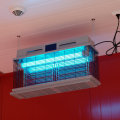Ultraviolet (UV) radiation is a form of light that is invisible to the human eye. It is found in sunlight and is also emitted by artificial sources such as tanning beds and welding torches. While UV radiation can be beneficial in small doses, it can also be dangerous and lead to a variety of health issues. Unprotected exposure to UV radiation can have serious health consequences, including skin cancer, premature aging, eye damage, and immune system suppression.
The two main types of UV radiation are UVA and UVB. UVA rays are longer in wavelength and penetrate deeper into the skin, causing wrinkles and age spots. UVB rays are shorter in wavelength and cause sunburns. Both types of UV radiation can damage the DNA of skin cells, leading to genetic mutations that can cause skin cancer. Skin cancer is the most common type of cancer in the United States.
It is caused by exposure to UV radiation from the sun or tanning beds. The two main types of skin cancer are melanoma and non-melanoma. Melanoma is the most dangerous form of skin cancer and can be fatal if not treated early. Non-melanoma skin cancers are less serious but can still cause disfigurement if not treated. In addition to skin cancer, unprotected exposure to UV radiation can cause premature aging and other skin damage.
This includes wrinkles, age spots, dryness, and discoloration. UV radiation can also weaken the immune system, making it harder for the body to fight off infections. Finally, UV radiation can cause eye damage such as cataracts and eyelid cancer. Cataracts are a clouding of the lens of the eye that can lead to vision loss. Eyelid cancer is a rare form of cancer that affects the eyelids. It is important to protect yourself from UV radiation by wearing sunscreen with an SPF of at least 30 when outdoors.
Wearing protective clothing such as hats and sunglasses can also help reduce your exposure to UV radiation.









